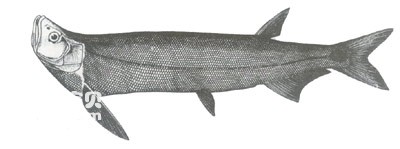Macrochirichthys macrochirius belongs to the order Cyprinidae, Cyprinidae, subfamily Macrochirius, and genus Macrochirius. English name: Long pectoral-fin minnow.
Endangerment level: Endangered.
The body is slender, extremely flat and thin, with an upturned head and a snout that is significantly higher than the back; the back and back of the head are straight; the body in front of the pectoral fins is significantly raised, and the ventral ribs are blade-shaped from the gill isthmus to the anus. Tip of the kiss. The mouth is large and upward, with the cleft almost perpendicular to the body axis; the lower jaw is protruding, with a hook-shaped front end embedded in the notch of the upper jaw. No need. The scales are very fine, and the arrangement of the body ends is very irregular; the lateral line is straight, and the lateral line scales are slightly larger, with 108-110 in number. The dorsal fin is positioned behind, opposite to the anal fin; the anal fin has a long base and more than 20 rays; the pectoral fin is longer than the head length and has a pointed tip; the pelvic fin is short and located close to the ventral rib; the caudal fin is large and deeply bifurcated. The back is blue-gray and the rest is silvery white; each fin is light yellow.

It mainly inhabits clear rivers in the plains of Southeast Asia. It likes to live in the upper layers of the water and is a carnivorous fish. In Southeast Asia, large fish are more than 500 mm long, and an individual with a body length of 280 mm was caught in Jinghong, Yunnan, my country.
Bigfin fish is distributed in the lower reaches of the Lancang River in Xishuangbanna, Yunnan; abroad it is distributed in Laos, Vietnam, Thailand and other places.
The distribution area of big-finned fish in my country is extremely narrow, and the number of individuals is very small. This species has poor adaptability to the environment, coupled with the serious human interference in the rivers where it lives, it has lost the basic conditions for life and reproduction, and the number of surviving individuals is very few. Although it is common in large rivers in central Thailand, it has not been seen in our country for many years.
animal tags:
We created this article in conjunction with AI technology, then made sure it was fact-checked and edited by a Animals Top editor.